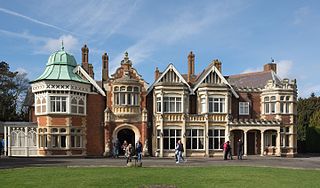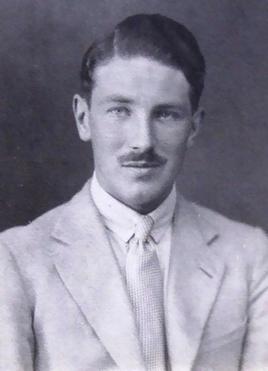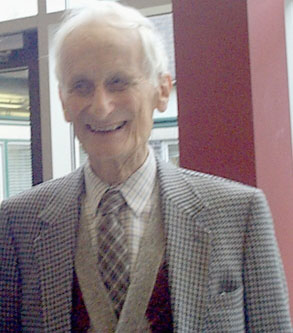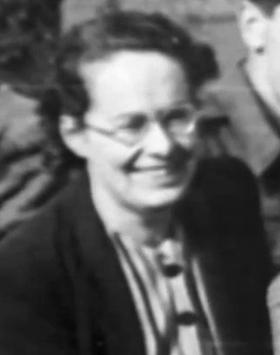This article needs additional citations for verification .(March 2013) |
This is a list of people associated with Bletchley Park , the principal centre of Allied code-breaking during the Second World War, notable either for their achievements there or elsewhere. Work at or for Bletchley Park is given first, followed by achievements elsewhere in parentheses.
Contents
- Sir Frank Ezra Adcock (Professor of Ancient History, Cambridge University)
- Alexander Aitken
- James Macrae Aitken, worked in Hut 6 (Scottish chess champion)
- Hugh Alexander, member of Hut 6 February 1940–March 1941, later head of Hut 8 (head of the cryptanalysis division at GCHQ; British Chess Champion 1938 and 1956)
- Maurice Allen, at the Wireless Experimental Centre, Delhi; an Oxford don. [1]
- Michael Arbuthnot Ashcroft (codebreaker)
- Stanley Armitage[ citation needed ]
- Pamela Ascherson, bombe operator (artist)
- Arthur Oliver Lonsdale Atkin (mathematician)
- John H. A. Atkins [2] (translator of Japanese, later Head of Modern Languages at Nottingham Trent University)
- Joyce Aylard, bombe operator at Eastcote, reassigned to Bletchley Park after VE day
- Dennis Babbage, chief cryptanalyst in Hut 6 (mathematician)
- Stephen Michael Alvin Banister, Codebreaker in Hut 6 and inventor of the 'BLISTS' or 'Banister Lists' - a register of Enigma messages showing special indicators to facilitate detection of certain items and identify crib messages. (Under Secretary at the Dept of the Environment)
- Rachel Joan Banister (née Rawlence), Codebreaker Hut 6
- Sarah Baring, linguist in Hut 4 (socialite and memoirist)
- Jean Barker, Baroness Trumpington née Jean Alys Campbell-Harris
- J. W. B. Barns, worked in Hut 4, Hut 5 and Block A (Professor of Egyptology, Oxford University)
- Geoffrey Barraclough (Chichele Professor of Modern History, University of Oxford)
- Keith Batey
- Mavis Batey née Lever, cryptologist (garden and landscape historian, author, former President of the Garden History Society)
- Rodney Bax, an Intelligence Corps captain in the Fusion Room, Hut 3. [3]
- Peter Benenson, worked in the "Testery" (founder of Amnesty International)
- Ralph Bennett, intelligence officer in Hut 3 (Professor of History at Magdalene College, Cambridge and president 1979-82) [4]
- Osla Benning, linguist Hut 4
- Francis (Frank) Birch, Head of German Naval Section
- Judith Irene Bloomfield (worked in Bletchley Park Mansion and Hut 8. Also the Foreign Office intelligence unit in Berkeley Street, London)
- T. S. R. Boase (art historian)
- Arthur Bonsall (Director of GCHQ)
- Elsie Booker, Wren, in photo with Dorothy Du Boisson
- Ruth Bourne (née Henry), Bombe operator [5] (in 2012 she was a volunteer guide at BP [6]
- Edward Boyle, intelligence (Conservative politician)
- Captain A. R. Bradshaw, senior naval officer at BP and in overall charge of administration of BP [7]
- Charles Brasch: Italian section, in Elmers School building and London. New Zealand poet.
- Hilary Brett or Brett-Smith, from Somerville College, Oxford, cryptologist, Hut 8 (Lady Hinsley) [8]
- Lord Asa Briggs, member of the Watch in Hut 6 (historian)
- Jean Briggs Watters, English cryptanalyst [9]
- Christine Brooke-Rose, from Somerville College, Oxford
- Tommy Brown, 16-year-old NAAFI canteen assistant who was awarded the George Medal for risking his life in helping Francis Fasson and Colin Grazier in recovering 'short signal' codebooks which provided a breakthrough in cryptanalysis of the German Naval Enigma from the sinking German submarine U-559
- Alan Bruce[ citation needed ]
- William Bundy, US Army Signal Corps (member of the CIA and foreign affairs advisor to Presidents John F. Kennedy and Lyndon B. Johnson)
- James Ramsay Montagu Butler (politician and historian)
- Elizabeth Byng[ citation needed ]
- John Cairncross, Soviet spy
- Peter Calvocoressi, intelligence officer (RAF)
- J. W. S. Cassels
- John Chadwick
- Caroline Chojecki MBE, intelligence database analyst (Soviet Studies Research Centre, Sandhurst database analyst) [10]
- John Christie, codebreaker[ citation needed ]
- Joan Clarke (later Murray), mathematician (briefly engaged to Alan Turing) [5]
- William Clarke, Head of Naval Section, then of Italian Naval subsection
- Tom Colvill, general Manager of the Testery [ citation needed ]
- Arthur Cooper, British Foreign Office linguist (Chinese and Japanese), FECB then FRUMEL [11]
- Josh Cooper, cryptographer
- Margaret Cooper (née Douglas) [12] [13] [14]
- Michael Crum, worked on the Siemens and Halske T52 teleprinter cipher, codenamed "STURGEON"[ citation needed ]
- Alec Naylor Dakin (cryptographer) worked in hut 4 decrypted premature message about death of Hitler during German assassination attempt
- Dorrit Dekk, Czechoslovakian emigrant designer who joined the Wrens and worked as a 'listener' during the war
- Alexander "Alistair" Denniston, Deputy Director of GC&CS
- Nakdimon ("Naky") Doniach, RAF, linguist (later GCHQ and Oxford University) [15] [16]
- Dorothy Du Boisson, operator of the Colossus computer
- Peter Edgerley, codebreaker[ citation needed ]
- Peter Ericsson, Testery shift-leader, linguist and senior codebreaker[ citation needed ]
- Margaret "Peggy" Erskine-Tulloch née Seton, one of the first Wrens at Bletchley Park, was a Bombe operator, instructor and watch officer [17] [18]
- John Davies Evans
- Francis Anthony Blair Fasson, Lieutenant RN was posthumously awarded the George Cross for the "outstanding bravery and steadfast devotion to duty in the face of danger" that he displayed on 30 October 1942 in boarding, with Able Seaman Colin Grazier, the sinking U-boat U-559 and recovering 'short signal' codebooks which provided a breakthrough in Cryptanalysis of the German Naval Enigma but losing his life in the process
- Jane Fawcett, was credited with identifying the message that led to the sinking of the battleship Bismarck , a great Allied naval victory [19]
- Harry Fensom, the creator of the British Tunny machine which was used in decoding messages in the Lorenz Cipher [20]
- Michael Field, foreign correspondent for the Daily Telegraph for thirty years, living in South America, Southeast Asia and France[ citation needed ]
- Harold Fletcher; Hut 6, involved in Bombe administration from August 1941 [21]
- Tommy Flowers, post office engineer and designer of the Colossus computer
- Leonard Forster [22]
- Hugh Foss, cryptographer, head of the Japanese Naval Section (Hut 7) from 1942 to 1943
- Freddy (Frederick) Freeborn, ran the Tabulating (index) Section in Block C (formerly Hut 7; former head of BTM's Letchworth factory. [23]
- Alfred Friendly, US Army Air Force (editor of the Washington Post )
- Valerie Glassborow, grandmother of Kate Middleton, Princess of Wales, worked in Hut 16 along with her twin sister [12]
- Joshua David Goldberg, Japanese codebreaker, solicitor
- Harry Golombek (chess player)
- I. J. (Jack) Good
- Raymond Goodman, head of one shift in Naval Intelligence under Frank Birch
- Colin Grazier, Able Seaman RN was posthumously awarded the George Cross for the "outstanding bravery and steadfast devotion to duty in the face of danger" that he displayed on 30 October 1942 in boarding, with Lieutenant Francis Fasson, the sinking U-559 and recovering 'short signal' codebooks which provided a breakthrough in Cryptanalysis of the German Naval Enigma but losing his life in the process
- Nigel de Grey, cryptologist, in World War I helped decrypt the Zimmermann Telegram
- Philip Hall
- John Herivel, arrived at Bletchley Park in January 1940; discoverer of the "Herivel Tip"; later worked in administration in the "Newmanry" (science historian)
- Peter Hilton, arrived at Bletchley Park in January 1942, worked in Hut 8 until late 1942, moved to Research Section to work on Fish, later in Testery (topologist)
- Harry Hinsley (historian)
- James Hogarth, worked on German naval cyphers e.g. Reservehandverfahren
- Gwen Hollington, worked in Hut 4, Bletchley Park, translating decrypted German naval communications
- Leonard Hooper (Director of GCHQ)
- Dorothy Hyson (American-born West End actress)
- John Constantine Ivanoff, [24] Cryptanalyst / Translator in the United States Army Signal Corps. Ordered to British Signal Intelligence Services in London, Ivanoff helped decode secret German transmissions.
- John Jeffreys, supervised manufacture of perforated sheets; initially in charge of Hut 6 with Welchman until May 1940; died in early 1941 (mathematician)
- Roy Jenkins, codebreaker in the Testery (Labour Member of Parliament and government minister; first British President of the European Commission (1977–81); one of the four principal founders of the Social Democratic Party (SDP) in 1981, ennobled as Baron Jenkins of Hillhead; distinguished writer, especially of biographies)
- Jones, Sergeant (later Squadron Leader); given overall responsibility for Bombe maintenance by Travis. [25]
- Daniel Jones, Japanese, Romanian and Russian codebreaker (Welsh composer)
- Eric Jones, head of Hut 3 (Director of GCHQ)
- Joan Joslin, cryptanalyst whose work helped lead to the sinking of the Scharnhorst
- Harold Keen, BTM engineer who built the British bombes
- Marjorie Jean Oswald Kennedy [26] [27]
- Dilly Knox, leading cryptologist, cracked the code of the commercial Enigma machines used in the Spanish Civil War, one of the British participants in the conference in which the Poles disclosed to their French and British allies their achievements in Enigma decryption, broke the Abwehr non-steckered Enigma
- Solomon Kullback, American mathematician and cryptologist who visited Bletchley Park in May 1942 and cooperated with the British in the solution of more conventional German codebook-based systems. Shortly after his return to the US, Kullback moved into the Japanese section as its chief, and later joined the National Security Agency.
- Leslie Lambert (short story writer as A. J. Alan)
- Peter Laslett
- Hugh Last (Professor of Ancient History at Brasenose College, Oxford)
- F. L. ("Peter") Lucas, Hut 3 1939–45, translator and intelligence-analyst, acting head Hut 3, C.O. BP Home Guard (writer; lecturer in literature, King's College, Cambridge)
- Arnold Lynch
- Sir John Marriott (philatelist)
- Peter Marr-Johnston headed Wireless Experimental Centre, Delhi; British Army officer. [28]
- Victor Masters, Testery shift-leader and senior codebreaker[ citation needed ]
- Joan Louisa McLean, Leading Wren 45270, wartime morse code operator
- George McVittie OBE, Air Section, Head of Meteorological Sub-section. (Professor of Astronomy at the University of Illinois)
- Stewart Menzies, non-operational Director of GC&CS (head of Secret Intelligence Service)
- Donald Michie, joined BP in the early summer of 1942' later worked with Colossus; had the idea for modifying it to become Colossus II, which could tackle 'wheel patterns' in addition to 'wheel settings'
- Stuart Milner-Barry, member of Hut 6 from early 1940 to the end of the war; head of Hut 6 from Autumn 1943 (chess player and civil servant)
- Max Newman, head of the "Newmanry" (topologist)
- Brinley ("Bryn") Newton-John (father of Olivia Newton-John)[ citation needed ]
- Rolf Noskwith, cryptographer
- Wilfrid Noyce, wartime Intelligence Officer, cryptanalyst (climber, 1953 Mt Everest expedition; knew Alan Turing)
- Denis Oswald, linguist and senior codebreaker[ citation needed ]
- Thaddeus ("Teddy") Pilley, RAF Intelligence Officer, linguist in Hut 3 (was made Officier d’Academie by France; helped found the International Association of Conference Interpreters and the Institute of Linguists; founded and ran the Linguists' Club)[ citation needed ]
- John H. Plumb
- Howard Newton Porter, US Army (philologist, Yale classics instructor, professor of classics at Columbia University)[ citation needed ]
- Lewis Franklin Powell Jr., US Army (member of the US Supreme Court)
- F.T. Prince (poet)
- Henry Reed, translator (poet and radio dramatist)
- David Rees, Hut 6 (mathematician)
- Marian Rejewski, Polish mathematician and cryptologist
- Grafton Melville Richards, ISOS, cryptographer, linguist and academic (Welsh and Celtic Studies). Author of Welsh language novel Y Gelyn Mewnol (The Enemy Within), (1943), Llandybie: Llyfrau'r Dryw.
- Jerry Roberts, Testery shift-leader, linguist and senior codebreaker
- James Robertson, Blocks A and F, Air Section. Ran BP Recreational Club Choral Society (Director of the Sadler's Wells Opera Company)
- Alison Robins, Wren
- Margaret Rock, mathematician
- Jim Rose, Hut 3, later journalist and campaigner [29]
- Pamela Rose, Hut 4 and Naval records, earlier actress, later school counsellor and charity chair [29]
- Bob Roseveare, Hut 6 (schoolteacher)
- Miriam Louisa Rothschild, author and scientist
- Mair Russell-Jones, cryptanalyst in Hut 6, working on the Enigma cipher. [30]
- John Saltmarsh (historian)
- Anne Segrave [31] (née Anne Hamilton-Grace; was indexer in Hut 3.in 1942,43, worked under F.L. Lucas, then Lavers; received a proposal of marriage from Ralph Tymms)
- D. R. Shackleton Bailey
- Arthur Shaw (cryptographer); RN, at the Far East Combined Bureau, founder and head of diplomatic section.
- Edward H. Simpson, cryptanalyst and mathematical statistician [32]
- Admiral Hugh Sinclair, non-operational Director of GC&CS (head of Secret Intelligence Service)
- Howard Smith (director general of MI5)
- Francis Hayward Stanton [33]
- Rosemary Brown Stanton [33]
- Rena Stewart [34]
- Oliver Strachey, head of the section deciphering Abwehr messages
- Alan Stripp, worked on Japanese codes (author of Codebreaker in the Far East)
- Sadie Stuart
- Joy Tamblin (Director of the Women's Royal Air Force)
- Derek Taunt, arrived in Bletchley Park in August 1941, worked in Hut 6 (mathematician, later bursar of Jesus College, Cambridge)
- Telford Taylor, US Army (Counsel for the Prosecution at the Nuremberg Trials)
- Ralph Tester, linguist, head of the Testery and member of a TICOM team (accountant with Unilever)
- John Thompson, codebreaker[ citation needed ]
- John Tiltman
- Edward Travis
- Michael Trumm[ citation needed ]
- Alan Turing, mathematician, logician, cryptanalyst, designer of the bombe, head of Hut 8 (pioneering computer scientist)
- W. T. Tutte
- Peter Twinn, first British cryptographer to read a German military Enigma message; became the head of the Abwehr Enigma section
- Ralph Tymms
- Jean Valentine, leading WRNS, Bombe operator
- Langdon Van Norden, US Army Signal Corps (chairman of the board of the Metropolitan Opera Association)
- Vernon Watkins
- Betty Webb (code breaker) served in the ATS (Auxiliary Territorial Service) then moved to Bletchley Park to help decipher Japanese and German encrypted messages
- Neil Leslie Webster, major in SIXTA, signals intelligence and codebreaking
- Gordon Welchman, initially in charge of Hut 6 with Jeffreys, became official head of the section until Autumn 1943; later Assistant Director of Mechanisation at Bletchley Park (author of The Hut Six Story, worked on secure communications systems for US forces)
- Peter Frederick West Maintained the Bombes at Bletchley Park
- J. H. C. Whitehead, Newmanry mathematician (topologist, one of the founders of homotopy theory)
- Bernard Willson, academic, worked in Hut 4 on Italian and Japanese codes
- Angus Wilson (novelist and short story writer)
- F. W. Winterbotham, RAF Intelligence Officer, responsible for devising SLU system for secure dissemination of Ultra (author of The Ultra Secret)
- Shaun Wylie, arrived at Bletchley in February 1941, head of crib section in Hut 8, transferred in Autumn 1943 to work on Tunny (topologist, mathematics lecturer at Cambridge, and head of mathematics at GCHQ)
- C. E. Wynn-Williams (physicist from the TRE; designed the electronic counters used in the Newmanry's Robinson machines and Colossus computers
- Leslie Yoxall, Hut 8, devised Yoxallismus technique












